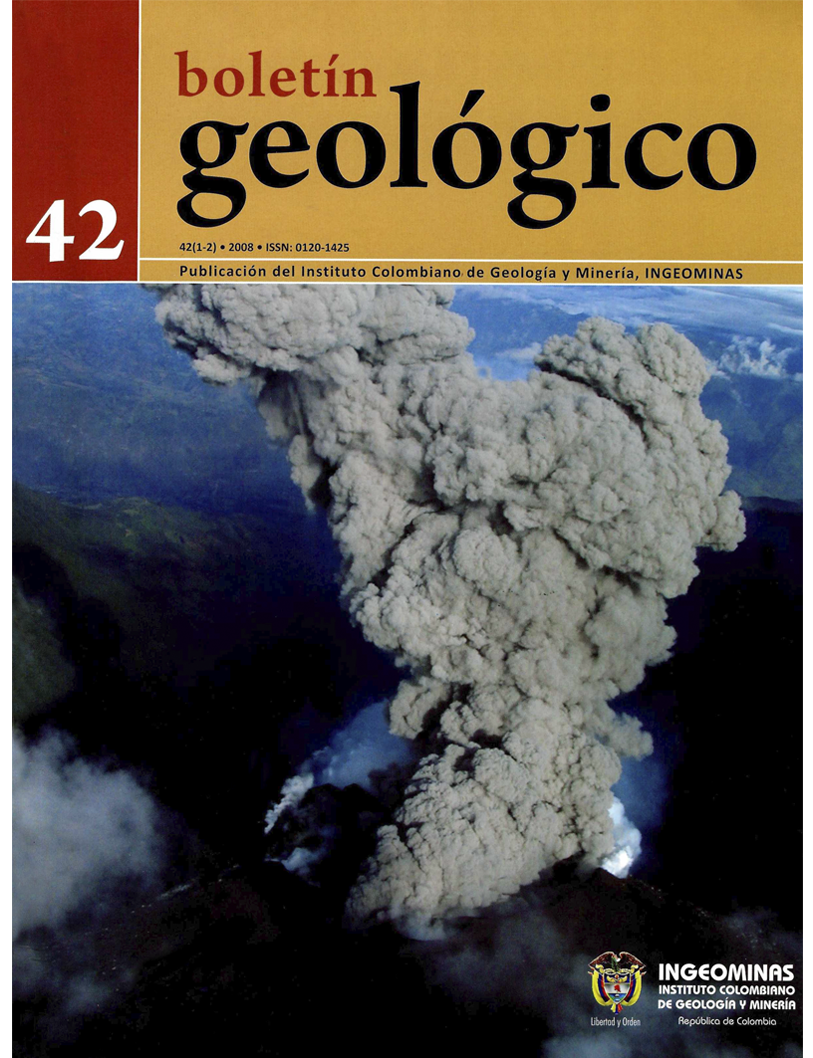Métodos e integración de análisis granulométrico para depósitos volcaniclásticos
Keywords:
Granulometric, point counting method, sieve method, pipette method, volcaniclastic depositsDownloads
How to Cite
Issue
Section
Published
Abstract
This work presents a review and description of sorne methods _and concepts which explain the application of methodologies to the granulometric evaluation of volcaniclastic deposits. Point counting, sieve and pipette methods are described along with a unification methodology which combines the results of each method in an equivalent distribution curve. Equally, an emphasis on the importance of this type off analysis is made taking into account the increasingly common development and utilization of empirical classification diagrams. In this way, the information given by these methods do not discriminate among different processes and make a quantitative description of the volcaniclastic deposits.
References
Arteta, R. (2001). Comparación de métodos de análisis mecánicos de suelos. Terra, 19, 219-225.
Capra, L. & Macías, J. L. (2000). Pleistocene cohesive debris flows at Nevado de Toluca Volcano, Central México. Journal of Volcanology and Geothermal Research, 102, 149-168.
Capra, L., Poblete, M. A. & Alvarado, R. (2004). The 1997 and 2001 lahars of Popocatépetl Volcano (Central Mexico): textural and sedimentology constraints on their origin and hazards. Journal of Volcanology and Geothermal Research, 131, 351-369.
Cas, R. A. F. & Wright, J. V. (1987). Volcanic successions, modern and ancient. London: Allen & Unwin Ltd.
Day, R. P. (1965). Pipette method of particle size analy- sis. Methods the Soils Analysis. Agronomy, 9, 553-562.
Fisher, R. V. & Schmincke, H. U. (1982). Pyroclastic rocks. Berlin: Springer-Verlag.
Folk, R. L. & Ward, W. C. (1957). Brazos river bar: a study in the significance of grain size parameters. Journal of Sedimentary Petrology, 27, 3-26.
Folk, R. L. (1974). Petrology of Sedimentary Rocks. Austin: The University of Texas, Hemphill.
Fritz, W. J. & Moore, J. N. (1988). Basics of physical stratigraphy and sedimentology. New York: John Wiley & Sons, Inc.
Herrera, S. & López, S. A. (2003). Estratigrafi'a de la formación Manizales y propuesta de un modelo de depósito. Tesis de pregrado. Manizales: Universidad de Caldas, Programa de Geología.
Inman, D. L. (1952). Measures for describing the size distribution of sediments. Journal of Sedimentary Petrology, 22, 125-145.
Kellerhals, R& Bray, D. I. (1971). Sampling pro cedures for coarse fluvial sediments. Journal of Hydraulics Division. Proceedings of the American Society of Civil Engineers, 1165-1180.
Krumbein, W C. (1934). Size frequency distributions of sediments. Journal of Sedimentary Petrology, 4, 65-77.
Laboratorio de Análisis de Suelos y Aguas de la Asociación Argentina de la Ciencia del Suelo. (2001). Siste- ma de apoyo metodológico. Secretaría de Agricultura, Ganadería y Pesca de la Nación Argentina. Boletines no editados difundidos, a partir de 1982.
Laboratorio de Edafología Ambiental de la Universidad Nacional Autónoma de México. (2001). Determinación de la textura por el método de la pipeta en suelos no volcánicos.
Major, J. J., Janda, R. J. & Daag, A. S. (1996). Watershed disturbance and lahars on the East Side of Mount Pinatubo during the mid-june 1991 eruptions, in Newhall, C. G. and Punungbayan, R. S. (eds). Pire and Mud: Eruptions and lahars of Mount Pinatubo, Philippines: Philippine Institute ofVolcanology and Seismology, Quezon City, and University of Washington Press, Seattle, pp. 895-919.
Mothes, P. A., Hall, M. L. &] anda, R. J. (1998). The enormous chillos valley lahar: an ash-flow-generated debris flow from Cotopaxi Volcano, Ecuador. Bulletin of Volcanology, 59, 233-244.
Murcia, H. F., Hurtado, B. O., Cortés, G.P., Macías,J. L. & Cepeda, H. (2008). The -2500 yr. B. P. Chicoral non-cohesive debris flow from Cerro Machín Volcano, Colombia. Journal of Volcanology and Geothermal Research, 171, 201-214.
Nikolskyi, B. l. (1963). Spravochik khimika (Manual de Química), I, 878, 985.
Pierson, T. C. & Scott, K. M. (1999). Superficial hydrologic hazards at volcanoes: debris avalanches, lahars and floods: processes, interpretation of deposits, and techniques of hazard assessment and mitigation. Open-File Report U.S. Geological Survey. Washington.
Pulgarín, B. A. (2000). Depósitos masivos del Pleistoceno Tardío asociados al colapso del flanco Sur del Volcán Nevado del Huila, Colombia. Tesis de maestría. Universidad Nacional Autónoma de México, Posgrado en Ciencias de la Tierra.
Schmidt, R. (1981). Descriptive nomenclature and classification of pyroclastic deposits and fragments: recommendations of the IUGS Subcommission on the Systematics ofigneous Rocks. Geology, 9, 41-43.
Scott, K.M., 1988. Origins, behavior, and sedimentology of lahars and lahar-runout flows in the ToutleCowlitz River system. U.S. Geological Survey Professional Paper 1447-A.
Sohn, Y K. & Cough, S. K. (1989). Depositional processes of the Suwolbong tuff ring, Cheju Island (Korea). Sedimentology, 36, 837-855.
Udden, J. A. (1914). Mechanical composition of clastic sediments. Geological Society of America. Bulletin, 25, 655-744.
Vallance, J. W. & Scott, K. M. (1997). The Osceola Mudflow from Mount Rainier: sedimentology and hazard implications of a huge clay-rich debris flow. GSA Bulletin, 9, 143-163.
Walker, G. P. L. (1971). Grain-size characteristics of pyroclastic deposits. Journal of Geology, 79, 696714.
Wentworth, C. K. (1922). A scale of grade and class terms for clastic sediment. Journal of Geology, 30, 377-392.
White,J. D. L. & Houghton, B. F. (2006). Primaryvolcaniclastic rocks. Geology, 34, 677-680.
Wolcott, J. & Church, M. (1971). Strategies for sampling spatially heterogeneous phenomena: the example of river gravels. Journal of Sedimentary Petrology, 61, 534-543.
Wolman, M.G. (1954). Amethod of sampling coarse river bed material. American Geophysical Unían Transactions, 35, 951-956.









